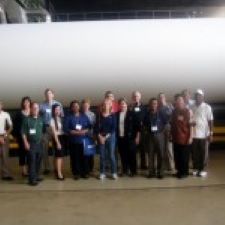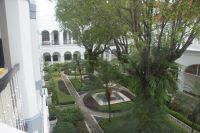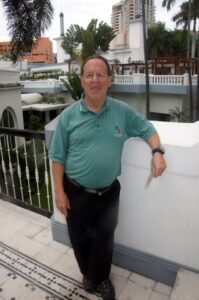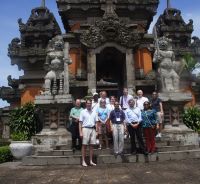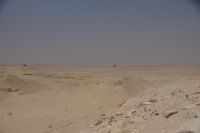Surabaya
It isn’t every day you wake up and find your picture in the newspaper, with the caption, “Professor Bisnis AS Kagumi Indonesia,” but that was how we started the day. If you don’t believe me (although you should!) check out the Jawa Pos and read about how and why the 15 members of the FDIB trip came to Indonesia. Considering that one of our faculty pointed out that New Orleans Times Picayune publishes only 3 days a week anymore, we were flattered to have our moment of fame in a paper whose circulation is growing!
The rest of the day filled in more parts of the Indonesian puzzle for us; after all, the purpose of our study trip is to learn more about Indonesia so we can take it back and share the information with other Americans, for whom, as I’ve said (as have others), Indonesia is the biggest country no one in America knows much about. The first visit took us to the port of Gresik, and through the countryside, which included some salt flats, to Maspion Industrial Estates, a joint venture with a Thai company that is the fifth feather in the Maspion group. The group, which touts itself as the “Pride of Indonesia” is representative of the kind of conglomerate we’ve seen before—a Chinese-Indonesian family (in this case two) that started in manufacturing—aluminum kitchenware—and selling it door to door; it now owns 34 companies and 14 joint ventures, with businesses ranging from shopping malls to the Singapore National Academy, an international school in Surabaya, to Bank Maspion, to electrical appliances—and so forth.
The Industrial Estate, started as a joint venture with the Germans, struggled to transfer technology; the current joint venture, with the Thais, seems to be working much better. An industrial estate is like a business park: it houses a number of businesses, many of them involving liquids—gas, oil, palm oil, etc., taking advantage of its being a port. The visit, which included a tour of the estate, revealed a number of businesses building factories, using the several jetties that allow docking and pumping of the liquid ashore. The biggest challenge, it seemed to me, highlights the challenge in general of doing business in Indonesia—that is, the lack of infrastructure. 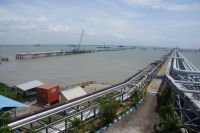 In the case of this industrial park, the question was partly whether the government or the industrial estate should build the jetties, or the roads, or even dredge the channel to the Java Sea. As it stands, the channel is not deep enough for the super tankers. As I saw in India, from the government standpoint, the question is where to start, and what to make a priority. The interisland roads seem to be the top of the list—understandable given the traffic jam that we encountered getting back to the city. Jam, I should point out, is the Bahasa word for hour—and we took two jams getting to our next appointment.
In the case of this industrial park, the question was partly whether the government or the industrial estate should build the jetties, or the roads, or even dredge the channel to the Java Sea. As it stands, the channel is not deep enough for the super tankers. As I saw in India, from the government standpoint, the question is where to start, and what to make a priority. The interisland roads seem to be the top of the list—understandable given the traffic jam that we encountered getting back to the city. Jam, I should point out, is the Bahasa word for hour—and we took two jams getting to our next appointment.
We sandwiched two visits to the UPH-Surabaya, which has been our host in Indonesia. The first was a luncheon with the head of the Lippo Foundation which has spearheaded the development of these overtly Christian institutions; he flew in from Jakarta for a few hours to welcome us, and to urge further cooperation between our schools—faculty and student exchanges, for example. The second visit was a talk from the Rector of the University, a Professor Mooy, whose credentials included a stint at the World Bank and as Ambassador to the European Union. It turned out that he was a University of Wisconsin graduate, too, and recalled watching Ron Vander Kellen almost pull out the Rose Bowl game in January 1963. The UW people beamed.
Mooy discussed two issues. One was the recent downturn in the economies of the United States and of Europe. The U.S. crisis he thought was more important because of the U.S. economic impact on the global economy. The U.S. government, he pointed out, bailed out the private sector; in Europe, the crisis was in the public sector, and the resolution remains.
He also shared some of his experiences in reforming the bank system in Indonesia. He did note that Indonesia was one of three countries that had a positive GNP growth in 2009, largely because of the non-reliance on the export sector. In giving him a gift from the group, I pointed out that infrastructure is important, but especially in service businesses, human capital is vital. A university is simply buildings without faculty and students, and he reminded me how important great teachers are.
Our other visit was to a nearby headquarters of the largest industrial gas  company in Indonesia, Aneka Gas. I had an inkling of its pedigree when I spotted a huge statue of the Guan Gong (the Chinese god of war and god of wealth) in one of the hallways. The company dates originally to a Dutch firm in 1916, and at various times was owned by the Japanese government, the Indonesian government, and a German company. None were able to make a go of it, but the Harsono family (Chinese Indonesian) bought it in 2004 and has become the largest of the five players in the industry—and the only Indonesia one. Its biggest customer is the medical industry, but it supplies oxygen, nitrogen, and argon—which it extracts from air—to 29% of the customers for those products. The competitive advantage, one of the directors told us, is local knowledge, which means knowing how and when to get payment. For its largest customers, it gets a 5-15 year contract, and will build a plant nearby. The director, a young woman with a degree from the University of Singapore, a management masters from UPH, also has a law degree from the University of Edinburgh, and dissected the company as though she were Michael Porter, the guru of business strategy. I should point out as well that she is the daughter of the owner!!
company in Indonesia, Aneka Gas. I had an inkling of its pedigree when I spotted a huge statue of the Guan Gong (the Chinese god of war and god of wealth) in one of the hallways. The company dates originally to a Dutch firm in 1916, and at various times was owned by the Japanese government, the Indonesian government, and a German company. None were able to make a go of it, but the Harsono family (Chinese Indonesian) bought it in 2004 and has become the largest of the five players in the industry—and the only Indonesia one. Its biggest customer is the medical industry, but it supplies oxygen, nitrogen, and argon—which it extracts from air—to 29% of the customers for those products. The competitive advantage, one of the directors told us, is local knowledge, which means knowing how and when to get payment. For its largest customers, it gets a 5-15 year contract, and will build a plant nearby. The director, a young woman with a degree from the University of Singapore, a management masters from UPH, also has a law degree from the University of Edinburgh, and dissected the company as though she were Michael Porter, the guru of business strategy. I should point out as well that she is the daughter of the owner!!
The day was capped with a visit to a batik store (which sold souvenirs, as well—remind me to tell some of you about jamu, and cat coffee), and a return to the hotel to prepare for the laborious packing for departure tomorrow to the famous island of Bali.
Salamat malaam.



